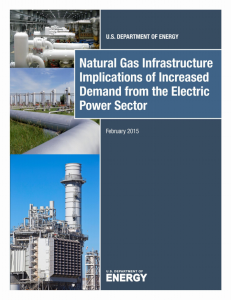Full Title: Natural Gas Infrastructure Implications of Increased Demand from the Electric Power Sector
Author(s): U.S. Department of Energy (DOE)
Publisher(s): U.S. Department of Energy (DOE)
Publication Date: February 1, 2015
Full Text: Download Resource
Description (excerpt):
Over the past decade, natural gas production in the United States has undergone a revolution. The combination of hydraulic fracturing and horizontal drilling technology has allowed economic access to enormous quantities of natural gas from shale formations. As a result, in 2013, the United States became the world’s largest producer of hydrocarbons.2 This development has had and will likely continue to have significant consequences for the broader economy. The impact of abundant, low-cost natural gas is particularly important in the electric power sector. During the month of April 2012, electricity generation from natural gas-fired plants virtually matched generation from coal-fired plants. 3 While coal has regained some of its market share because of gradually rising natural gas prices, growth in natural gas generation is projected to continue in the future.4
Increased use of natural gas in electric generation presents some potential challenges. While coal can typically be stored on-site at power plants, natural gas must be delivered as it is used.5 Because adequate natural gas infrastructure is a key component of electric system reliability in many regions, it is important to understand the implications of greater natural gas demand for the infrastructure required to deliver natural gas to end users, including electric generators.
The United States has more than 217,000 miles of interstate natural gas pipelines to deliver natural gas from producing regions to end users.6 However, the continued development of natural gas from shale formations, which tend to be situated outside of traditional natural gas producing regions, will require new pipeline infrastructure and/or the repurposing of existing infrastructure.
